Hengistbury Head in the 19th Century
The smuggling which epitomised the 18th century activities on Hengistbury Head continued, and arguably was at its height in the early 1800's. It was not until the 1850's that the government gained the upper hand and smuggling became a rarity rather than the norm.
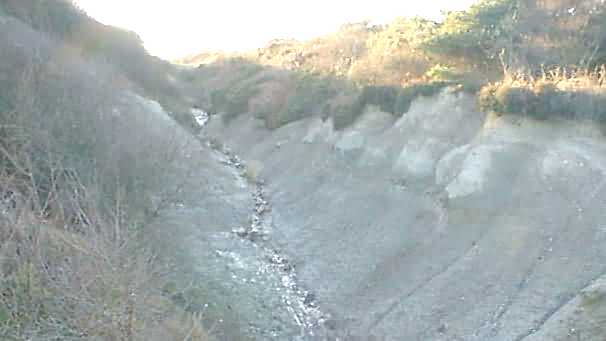
A permanent scar on the landscape of Hengistbury Head is the Northern end of the Iron stone quarry.
As smuggling ended, other uses for Hengistbury Head came to the fore. A local Coal merchant by the name of George Holloway found a way of mitigating the loss of profit on returning empty coal barges. He gained mining rights from the Lord of the Manor who claimed foreshore rights (although these are normally attributed to the Crown) and exploited the iron ore doggers found at Hengistbury Head. These were initially used as ballast on the barges back to Southampton. They were then transferred to the larger coal ships trading from Cardiff (again as ballast) and finally delivered to the blast furnaces of Merthyr Tydfil and the Rhondda in South Wales.
Essentially Mr Holloway was simply adding a layer of efficiency to his main activity as a coal merchant. Unfortunately the removal of the Iron Stone Doggers de-stabilised Hengistbury Head. The stones piled on the foreshore and laying in the inshore waters had protected Hengistbury Head from erosion for millenia. Suddenly the sea was able to batter the base of the cliff and carry away the sand. Hengistbury Head began to recede. In addition to the removal of the sea and beach iron ore deposits, an open cast mine was set up approximately half way along Hengistbury Head.
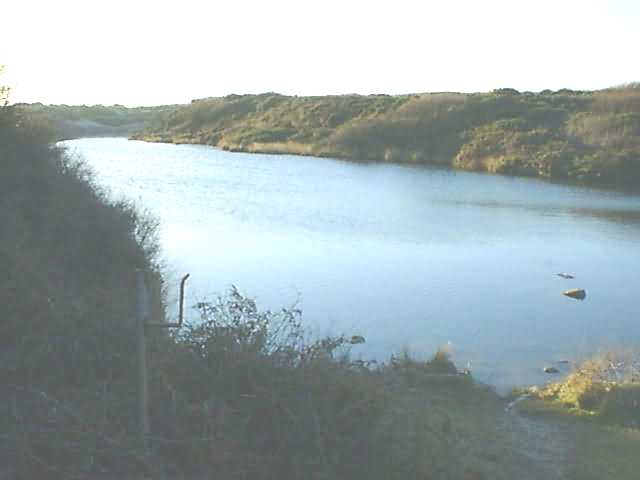
The southern aspect of the quarry has been turned into a scenic lake, although it is too acidic to support much aquatic life
The ironstone dredged up from the reef, mined in the quarry and collected from the beach were shipped out via Holloway's Dock. This was a small quay set up in what is now marsh land where Hengistbury Head joins with Mudeford Sandspit. But this small dock also recieved inbound raw materials. Limestone and probably chalk dredged up from the remains of the chalk ridge that once joined the Needles to Purbeck were brought in to provide one of the raw materials for the manufacture of Quicklime.
Cement is a relatively new invention and did not exist before the 20th century. Buildings prior to this date used Lime based mortar. Production of the mortar was a major industry. In fact most small ports and canal docks served a nearby lime kiln that produced the Quicklime required to make the mortar.Lime based mortar is made by adding water to Quicklime (referred to as slaking) and then adding sand or gravel to the "slaked lime" as we do today with cement.This was (and is) a potentially dangerous operation as a great deal of heat can be generated during the slaking process. All through history there are stories of people being badly injured or even killed because they tried to short-cut the slow and careful procedure needed to manufacture and use Quick Lime. Quicklime and the associated lime based morter date back to the very depths of antinquity and the use of lime based mortar in the construction of brick dwellings was universal before the middle of the 20th century. Quicklime is manufactured by heating chalk or limestone to more than 700 degrees centrigrade in a kiln. Due to the difficulty in transporting and storing Quicklime, it was was usually manufactured at coastal ports where access to the raw materials of coal and limestone (or chalk) was relatively easy. Consequently one of the industrial products produced at Hengistbury Head was Quicklime. Old Lime kilns still exist there today. Although they are overgrown with scrub and full of sand they would probably still be capable of producing Quick Lime with a little refurbishment. The manufacture of Quicklime is one of the forgotten industries of Hengistbury Head.
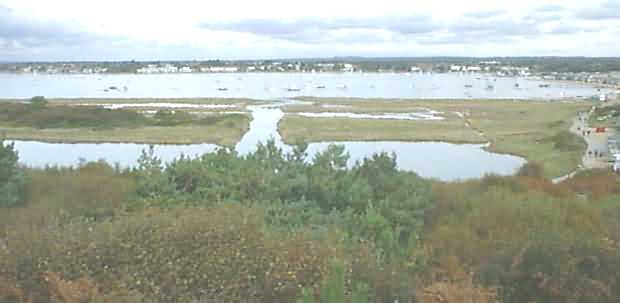
Holloway's Dock as it is now viewed from Hengistbury Head
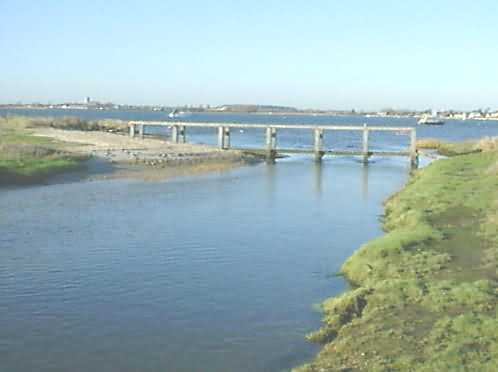
The exit of Holloway's canal into Christchurch harbour
The spoil from the open cast mining activity was dumped along the north eastern side of Hengistbury Head and is and area now known as the Batters. This mining spoil remains there today, overgrown and unnoticed.
After the removal of the iron ore doggers from the sea and from the beach, rapid erosion of Hengistbury Head took place. Several reports were issued to the admiralty from sea-farers who found the previously sheltered anchorages in Christchurch bay were becoming exposed to the prevailing westerly winds. Possibly due to these detrimental effects upon the environment Holloway's dredging off Hengistbury Head was halted. The extraction of iron from the sea had ended by 1856 although further extraction from other places continued until the 1870's. The erosion of Hengistbury Head continued unabated and apparently unnoticed (or at least uncared for) for the next fifty years.
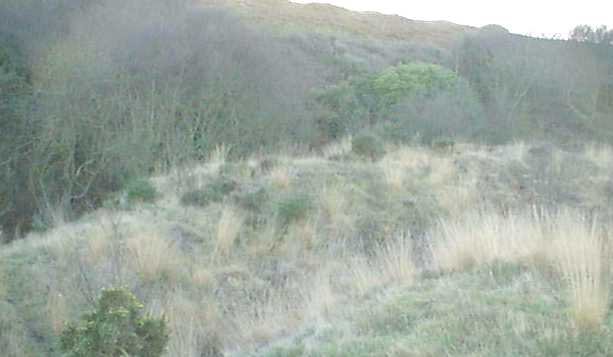
The Batters. The spoil from the mine was dumped on the North Western end of Hengistbury Head
While Holloway was busily mining the Hengistbury ironstone doggers others were developing schemes for Christchurch harbour. Reports were made by William Armstrong and John Silvester proposing development for Christchurch Harbour, but Christchurch Council, after having commissioned these reports, had neither the resources or the willingness to carry them through.
The final set of development plans for Christchurch Harbour was set forward in 1885 by the Christchurch and Wimborne Railway Company. No doubt they intended to develop the rudimentary dock and cargo transportation facilities set up by The Hengistbury Mining Company. This scheme was by far the grandest,planning a 1000 yard (approx. 900 metre) breakwater to protect the harbour entrance. A major dock would have been set up by Long Field, to the North West of Hengistbury Head. A railway line from Wimborne was planned to link up to this dock. However in the end the backers of this scheme withdrew their support and the scheme folded.
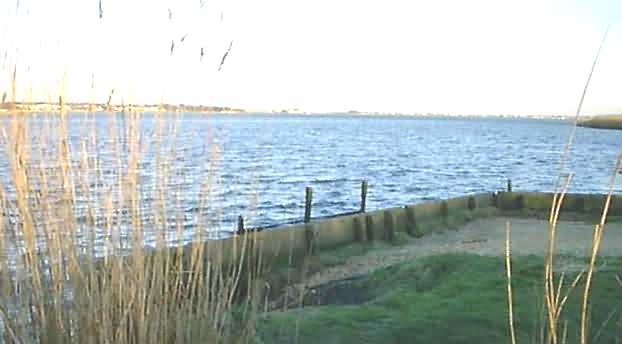
The fishing platform 50 metres east of the Sail Training centre A lonely place sitting on the edge of Lime Kiln Channel
Today, 50 meters east of the Sail Training Centre, and only accessible via a narrow path through the reed beds, is a small landing stage. It is currently used as a fishing platform. Once I imagined that this place could have been the beginnings of the failed harbour scheme. But the clue to it's true original use is given away in the local name for the deep water channel that runs by it. It is called the "Lime Kiln Channel".
No doubt John Holloway and the Hengistbury Mining Company would have also had a hand in producing the Quicklime. The little fishing platform and Holloways Dock would have been ideally placed to provide the raw materials. The resultant Quicklime could then be shipped up river to Christchurch and over the heath to the rapidly expanding new town of Bournemouth.